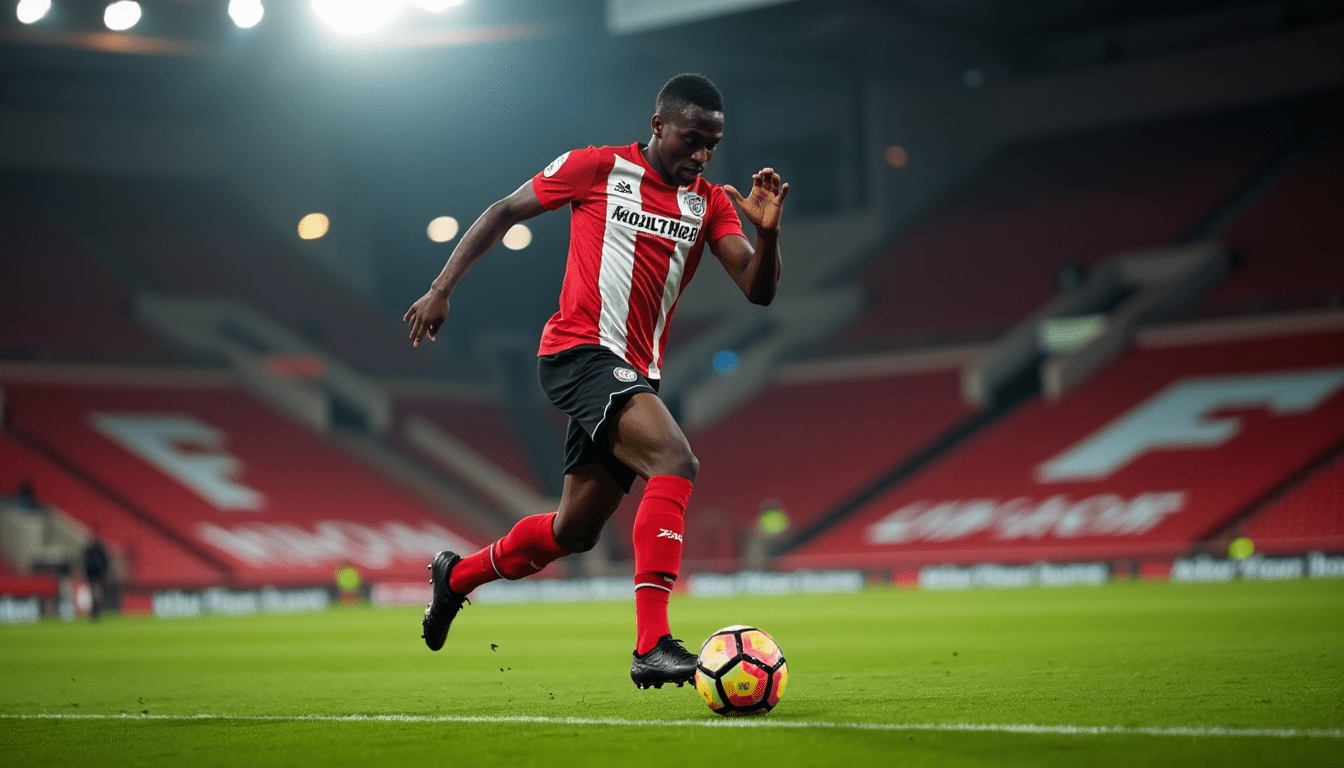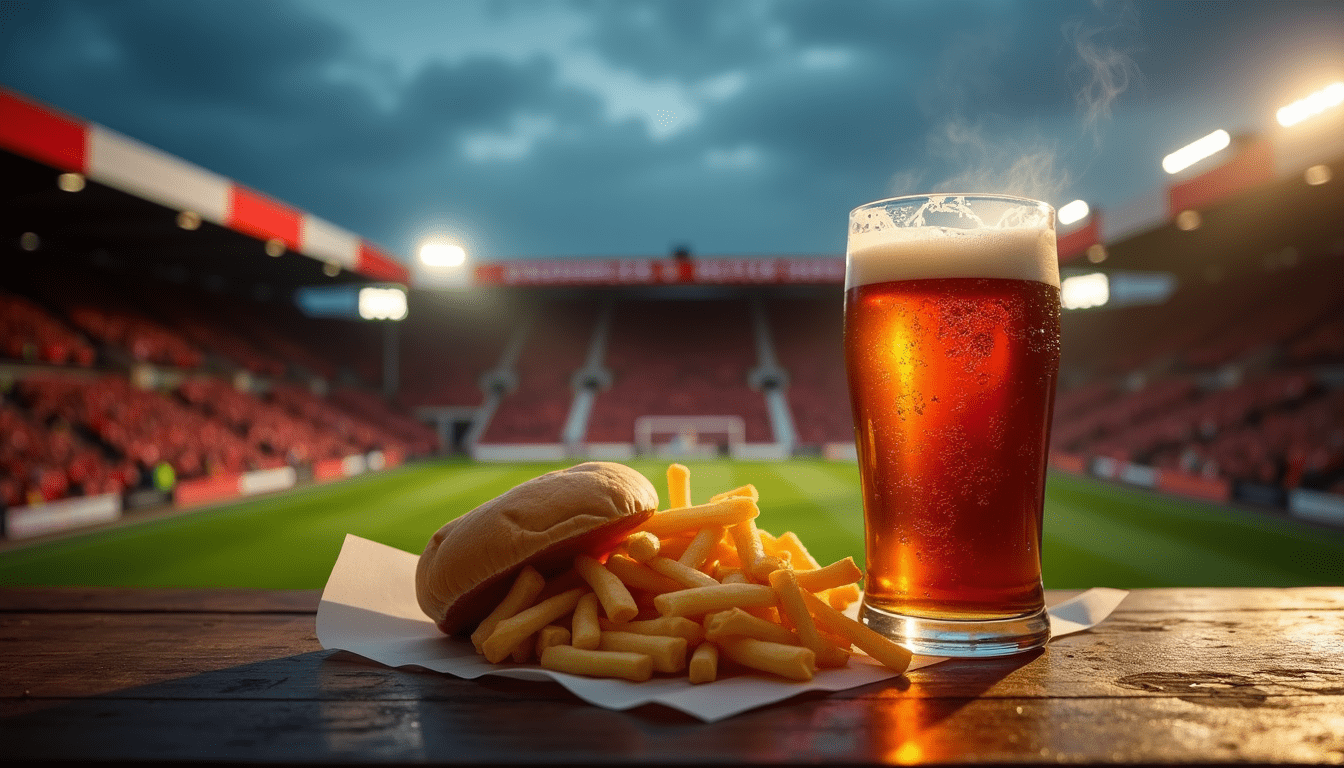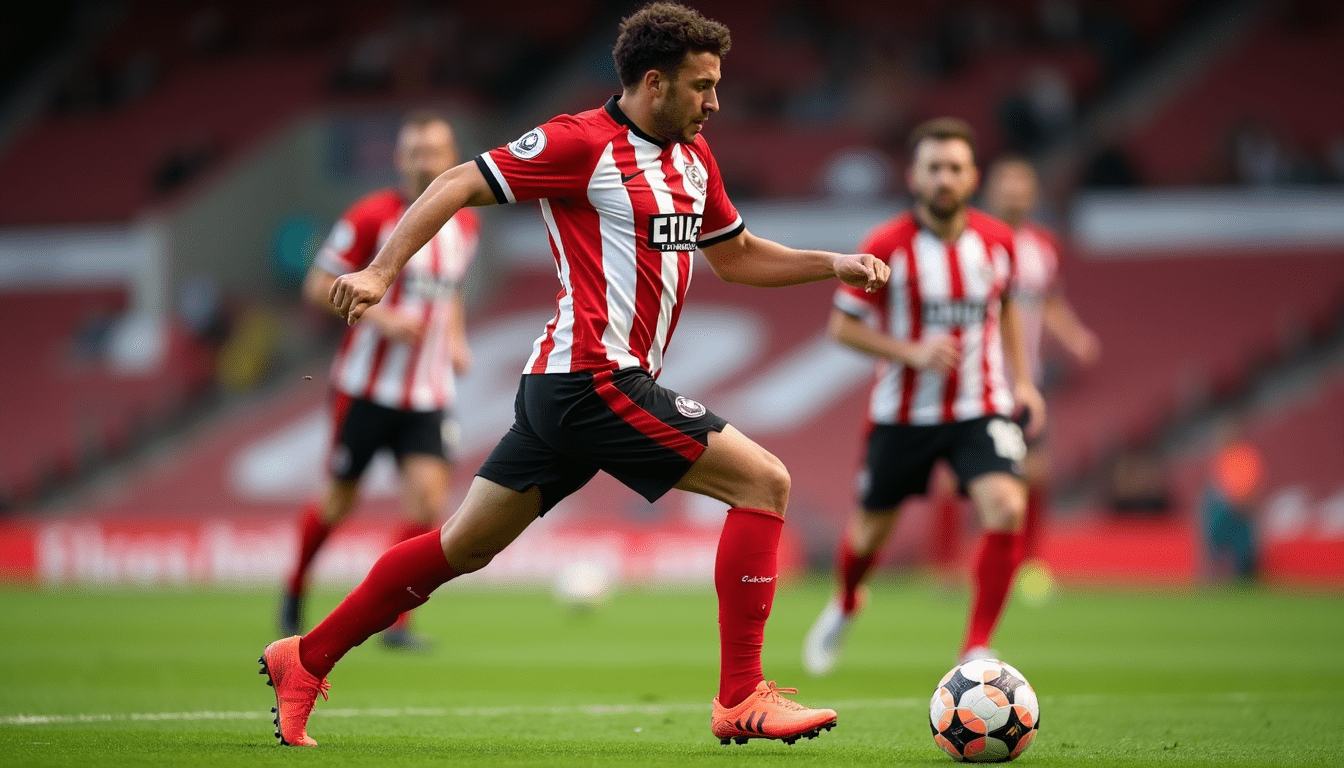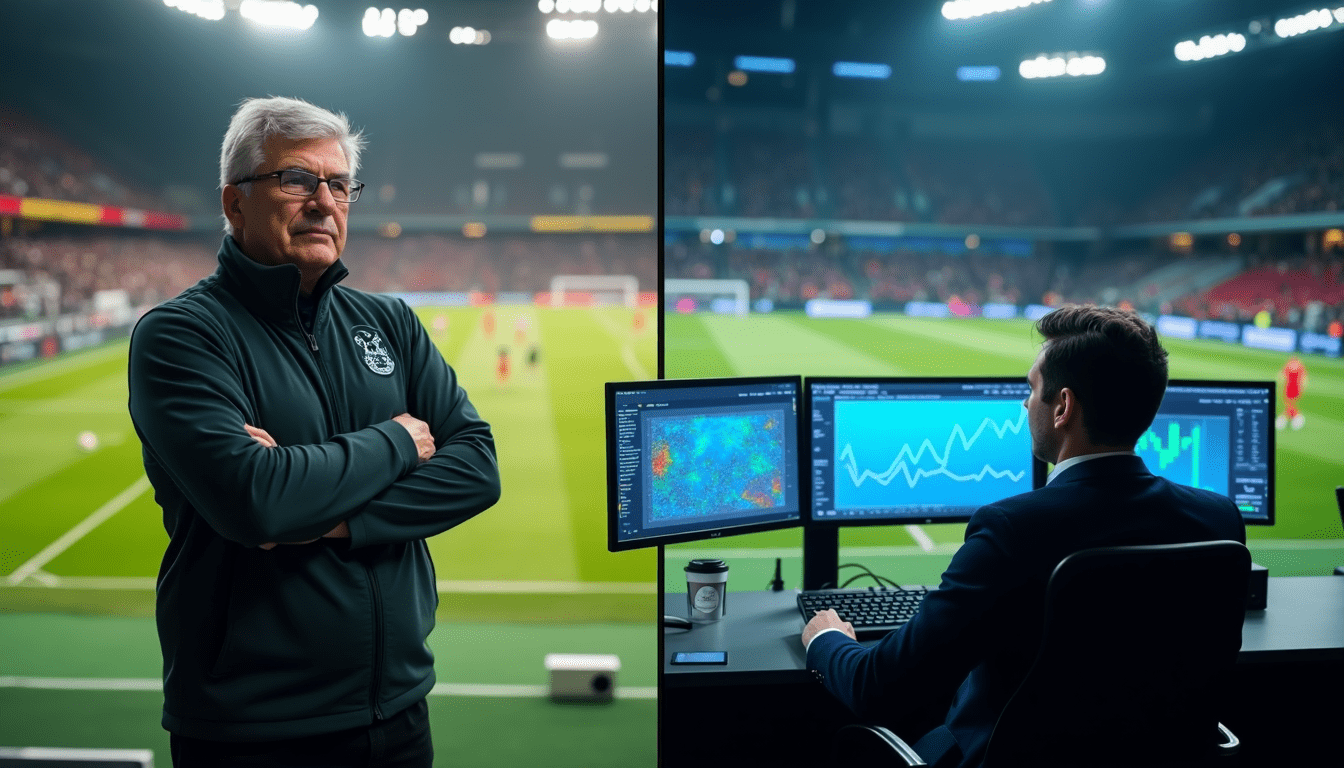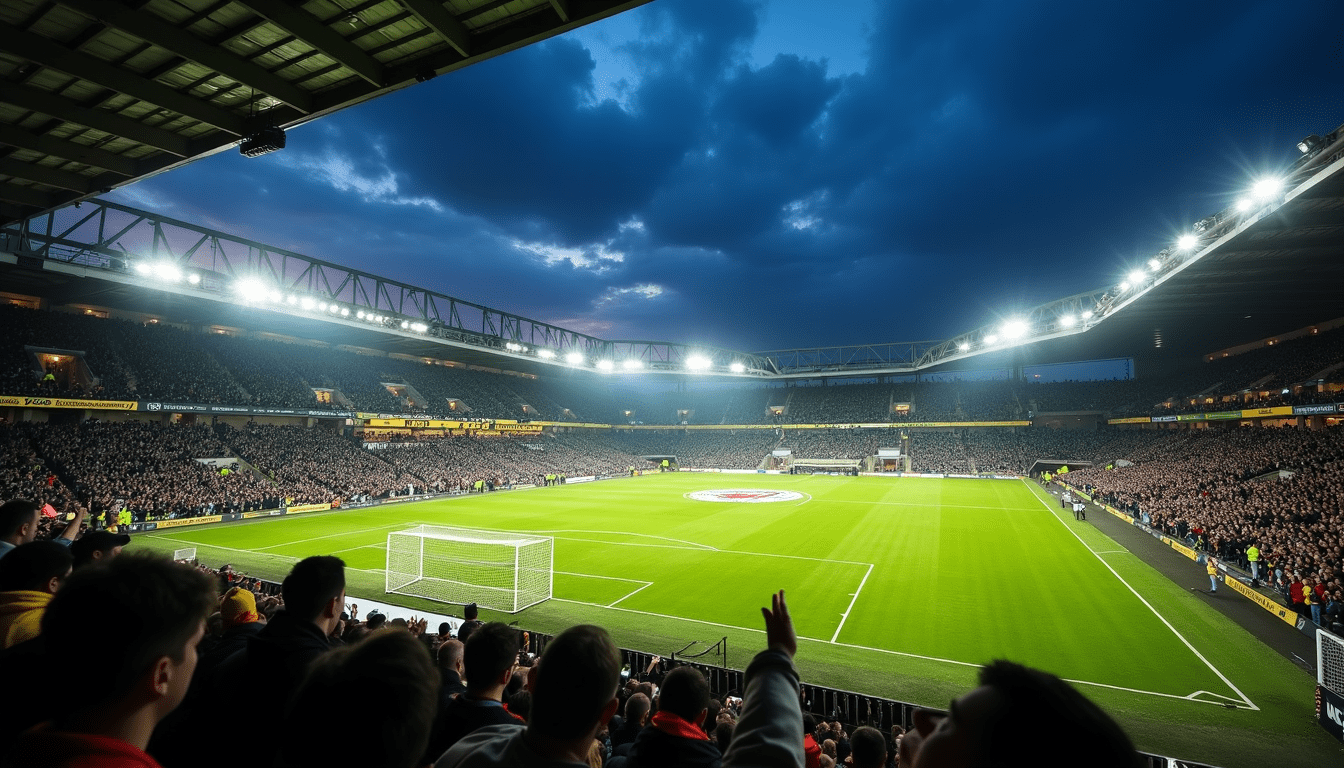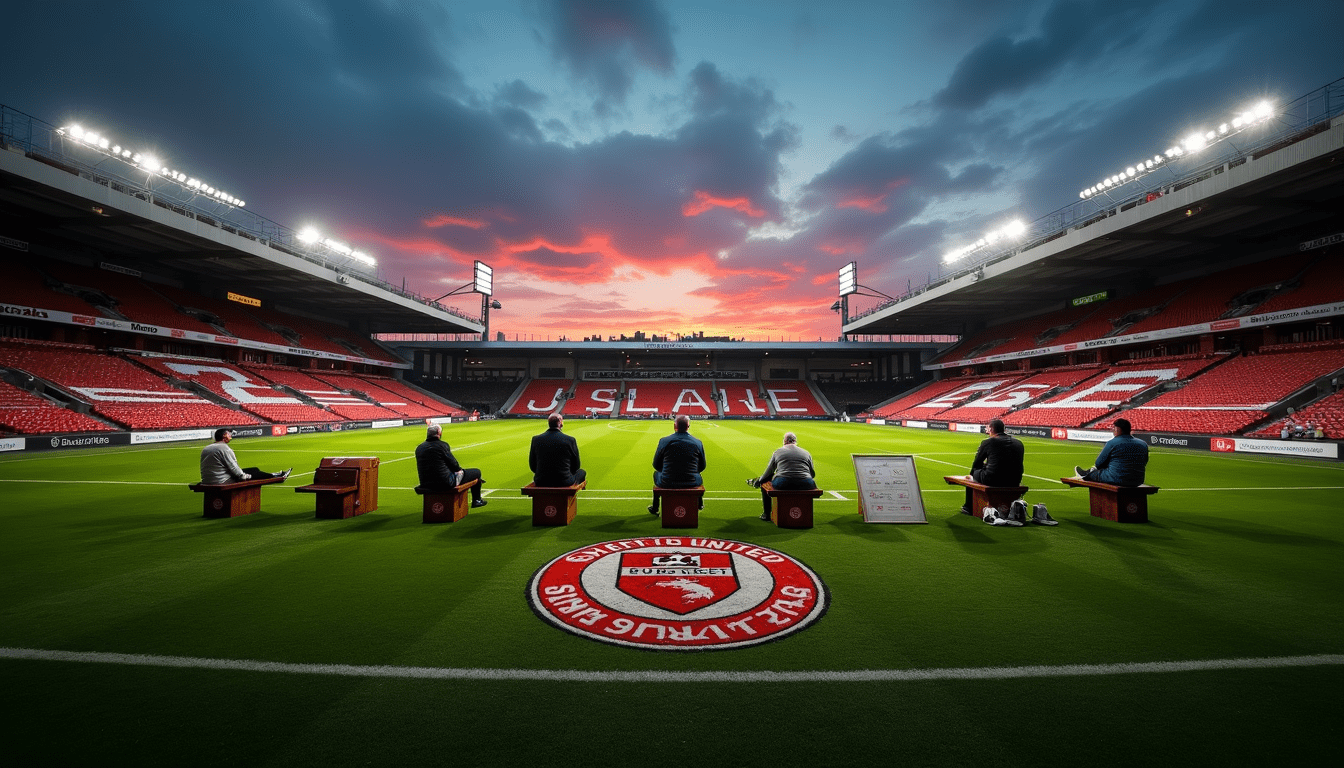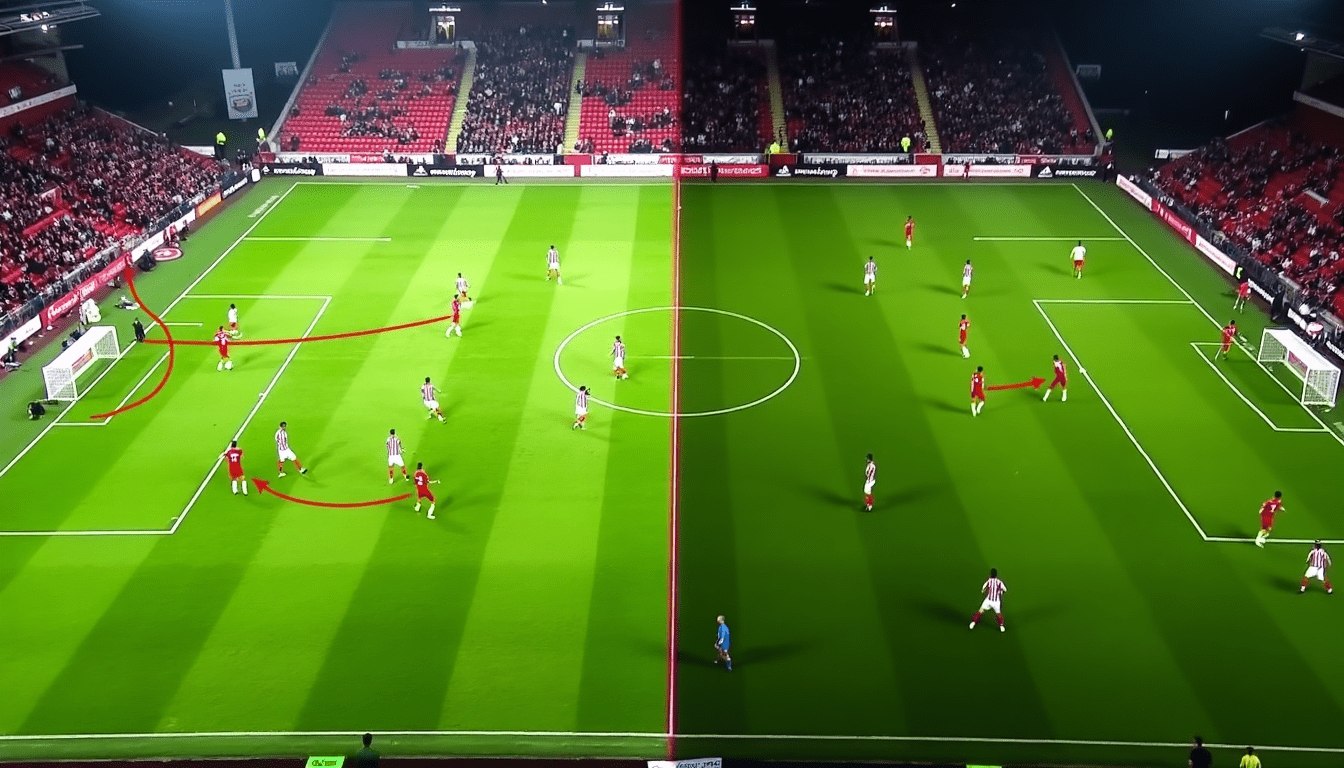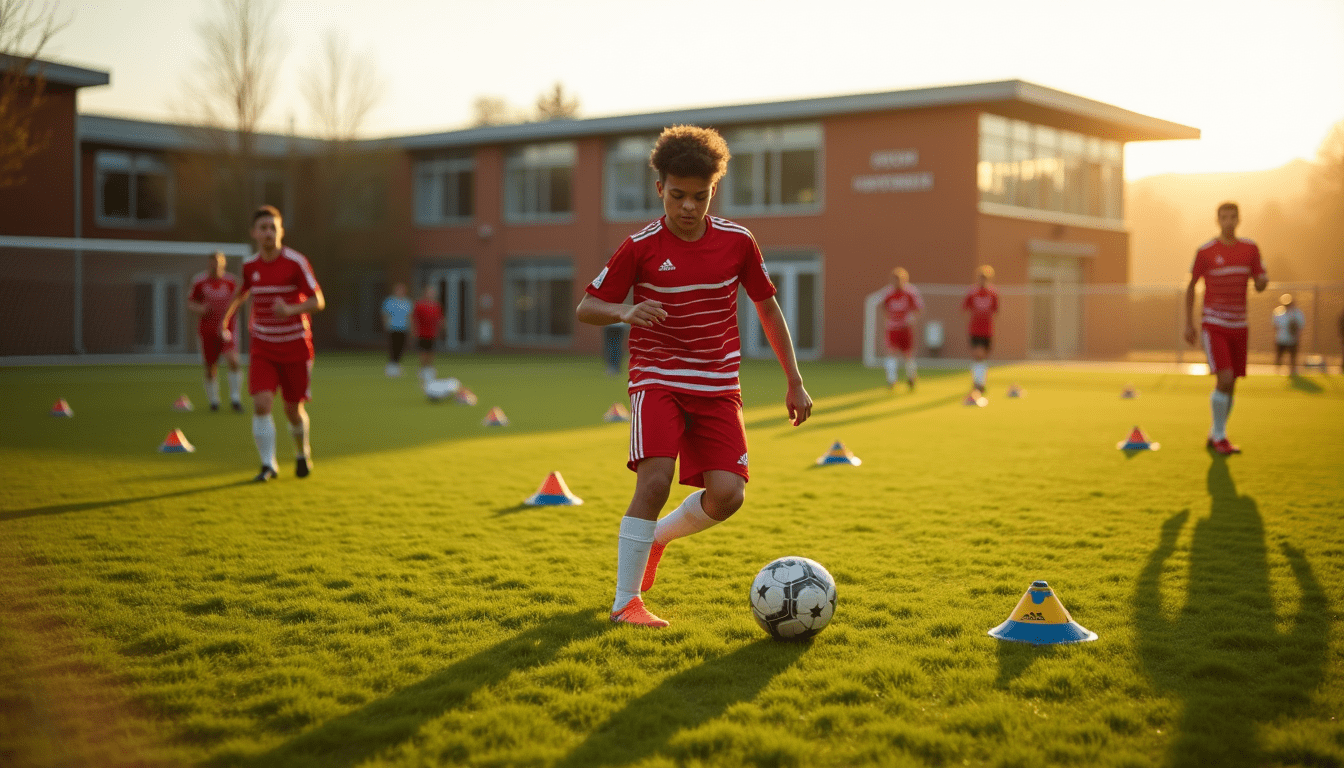
Wearable Technology in Sport is interesting – 18 out of 32 teams at the 2022 FIFA World Cup used wearable technology to get ahead of their competition.
Football has changed faster over the last several years, thanks to advances in sports science, data analytics, and technology. Teams have revolutionized their training and performance methods with GPS-tracking vests and devices that give detailed information about athlete performance. Technology’s role in sports is vital now. It changes everything from how players move to preventing injuries.
I’ve put together a complete list of 13 state-of-the-art wearable tools that top football teams use in 2025. These tools do more than track performance metrics – they use AI-driven analytics to suggest customized training plans. These solutions will help you make informed decisions for your athletes, whether you manage a professional team or want to improve your training equipment.
Catapult One GPS Tracker

Image Source: Catapult One Team
Catapult One leads the GPS tracking market. It detects up to 1,250 movements per second and tracks positions within 100cm. The device’s advanced movement analysis has changed how teams monitor their players.
Player Movement Pattern Analysis
The system breaks down movements into six intensity levels. These range from very low (standing-like movements) to dynamic high intensity (sharp turning and directional changes). Players spend 25% of their pitch time making multi-directional movements during matches. Advanced inertial sensors help quantify both locomotive and mechanical aspects. This gives a complete view of player activity patterns.
Load Management Features
The PlayerLoad metric was created with the Australian Institute of Sport. It measures instant and total workload without relying on distance. Players who used Catapult One for three straight months saw great results. Their total distance went up by 12%, sprint distance grew by 26%, and top speed improved by 3.5%.
How Barcelona FC Uses Catapult Data
Barcelona FC blends Catapult’s technology with their performance analysis system. FIFA tested the system’s accuracy at Camp Nou. The club’s medical teams and coaches use this data to analyze tactics and monitor player health. Barcelona’s facilities have become a leading sports testing ground.
Tech in Sports: Tactical Applications
The system does more than simple tracking. Coaches can compare training patterns with match requirements. This helps them create practice sessions that match game intensity levels. On top of that, it allows live monitoring of mechanical load, especially when training intensity peaks.
Pricing and Accessibility
Catapult has two main solutions: Vector Pro and Vector Core. Vector Pro comes with:
- 10Hz GPS / 400Hz LPS capability
- ECG-derived heart rate monitoring
- Over 15 live metrics
- Indoor and outdoor tracking
Vector Core offers simple features that work well for smaller organizations:
- 10Hz GPS outdoors
- Indoor inertial data
- Heart rate monitoring
- 11 live metrics
Independent research verifies the system’s quality. Catapult became the first company to get FIFA’s approval for in-match use. More than 1,200 football teams worldwide now use this wearable technology. Top clubs like Real Madrid and Chelsea FC are among them.
STATSports Apex Pro Series

Image Source: STATSports
STATSports has created a breakthrough in sports wearable technology with their Apex Pro Series. Their system combines an 18Hz GPS system with a 952Hz accelerometer. This advanced monitoring solution gives coaches the most accurate player tracking and performance analysis available today.
Real-Time Tactical Metrics
Coaches can track 16 different metrics for volume, speed, and cardio parameters with the system’s live monitoring features. The Sonra Live iPad and Watch apps let coaching staff watch both individual and team loads at once. The system calculates metrics right on the unit, which means no data loss even when players move out of range.
Heart Rate Variability Monitoring
The Apex Pro Series’ heart rate variability (HRV) analysis helps teams learn about player fatigue and recovery. Research shows that lower HRV is linked to poor cardiovascular adaptation and possible overtraining risks. The system keeps track of:
- Average heart rate in beats per minute
- Maximum heart rate peaks
- Strain levels and step impact analysis
Case Study: England National Team Implementation
The England National Team’s choice to use STATSports technology shows how well it works at the elite level. The team now has:
- Better tracking of high-speed running metrics
- Sprint repetition analysis with short recovery periods
- Better match preparation levels
Data Security Protocols
STATSports has built reliable data protection measures because players worry about their privacy. Recent surveys show 78% of professional footballers worry about misuse of their biometric data. The system now includes:
- Centralized data hub with restricted access protocols
- The industry’s fastest data download speeds
- Secure cloud infrastructure powered by Microsoft Azure
The system does much more than simple tracking. One major European client cut their soft-tissue injuries in half – from 44 to 22 – in their first year. The technology also helps monitor rehabilitation for up to 8 athletes at once across 25 metrics.
The Apex Pro Series stands out by using advanced GNSS technology in its fixed infrastructure. This maintains data quality even in tough spots like semi-enclosed stadiums. Top teams like Manchester United, Liverpool, PSG, and Juventus have made this sports technology their top choice.
Playermaker UNO Foot-Mounted Sensor

Image Source: The Soccer Handbook
Playermaker’s foot-mounted sensor system marks a major step forward in sports wearable technology. The system uses 6-axis smart sensors that sample movement 7,000 times per second. FIFA has approved this innovative performance tracking device, making it the first foot-mounted system players can use during matches.
Technical Skill Analysis
The system’s smart AI algorithms track over 25 different metrics to learn about player performance. The key technical measurements look at:
- Kicking power and ball release velocity
- Total ball possessions and control duration
- Time-to-release analysis to assess decision-making
- Foot zone contact mapping that helps refine technique
Ball Touch Quality Metrics
Smart motion capture technology lets the sensors measure ground impact, ball contact, and foot rotation patterns with precision. The system measures performance in five main categories:
- Involvement metrics that track touches and releases
- Playing tempo analysis based on possession duration
- Technical balance evaluation between both feet
- Speed measurements with sprint analysis
- Volume metrics that cover distance and work rate
Youth Development Applications
This technology works especially well for developing young talent in football. Studies show that old training methods mostly depend on what coaches observe. The AI-driven approach by Playermaker helps with:
- Automatic detection of ball touches and game events
- Creating passing networks that show how players connect
- Immediate biomechanical load tracking through each foot
- Custom development paths based on performance data
Comparison with Video Analysis
The foot-mounted sensors give quick tactical insights without needing manual video coding. Tests show the system matches video analysis with excellent accuracy (95.1% – 100.0%) and reliability (95.9% – 96.9%). The technology naturally merges with video footage through timestamp synchronization. This helps coaches:
- Find specific event clips right away
- Study technical actions during training
- See how different positions affect performance
The system does more than just basic tracking. More than 200 professional clubs worldwide now use it, including Manchester City, LA Galaxy, and Borussia Dortmund. Playermaker keeps improving its technology through partnerships with top teams. A great example is their work with Manchester City to create the CITYPLAY system, which uses the club’s proven development methods.
WHOOP 4.0 Recovery Wristband

Image Source: Evening Standard
Professional football teams now depend on advanced recovery monitoring systems. WHOOP 4.0 stands out as a breakthrough wearable technology in sports. This smart wristband tracks player wellness through multiple body markers and gives unprecedented insights into their condition.
Sleep Quality Optimization
WHOOP measures all four sleep stages—slow wave, REM, light, and awake—as accurately as a laboratory. The device calculates how much sleep each player needs based on their recent patterns, daily strain, sleep debt, and nap time. The system watches wake events, efficiency, and breathing rate continuously to recommend the best sleep schedule.
Recovery Rate Tracking
Players get a daily Recovery Score from 0-100 that shows how their body responds to physical and mental stress. The score comes from analyzing heart rate variability, resting heart rate, and breathing rate. Players can quickly understand their readiness through three simple colors:
- Green: Peak performance ready
- Yellow: Keep current intensity
- Red: Need more rest
Arsenal FC’s Recovery Protocol Integration
WHOOP has changed how Arsenal FC monitors player recovery. Team members like Beth Mead and Katie McCabe use the device’s team features actively. Players created their own community group in the app that encourages friendly competition through metric comparisons. The system helps players manage their sleep schedules effectively during long trips and when routines change.
Subscription Model for Teams
The professional-grade WHOOP package comes with a yearly membership that has:
- The WHOOP 4.0 device
- Onyx SuperKnit band
- Wireless and waterproof battery pack
- Full app access
- Lifetime warranty
- 24/7 support
Teams get extra features through the WHOOP app platform. Coaches can see leaderboards that show strain, recovery, and sleep metrics. Team owners can adjust data sharing settings and control member access. This setup lets them track performance completely while protecting player privacy.
Polar Team Pro System

Image Source: Polar
The Polar Team Pro System represents a major step forward in performance tracking. Its lightweight 38-gram sensor measures detailed player data. This sports wearable technology combines GPS tracking with motion sensing to provide unique insights into team performance.
Cardiovascular Load Monitoring
The system tracks heart rate metrics with great accuracy. It records maximum rates from 165-188 bpm and average rates between 119-145 bpm during training sessions. The smart algorithms help coaches monitor:
- Heart rate zones distribution
- Training load quantification
- Cardiovascular adaptation patterns
Training Intensity Distribution Analysis
Studies show the system categorizes training intensities into clear zones. Players spend their time like this:
- 76% in low-intensity zones
- 6% in intermediate zones
- 18% in high-intensity zones
Real-Time Coaching Feedback Features
Coaches receive live data on their iPads within a 200-meter range. This sports technology breakthrough lets them analyze:
- Player statistics and detailed performance data
- Team-wide comparisons and standards
- Session markers and coaching notes
Multi-Player Dashboard Functionality
The dashboard can track up to 60 players at once. Data appears in three main views:
- List view for individual metrics
- Whole team overview
- Player comparison analysis
The system’s web service helps with deeper performance analysis by storing data in a cloud-based tracking system. This detailed approach lets teams:
- Create detailed player profiles
- Track long-term progress
- Share reports among coaching staff
The platform does more than simple tracking, as shown by top clubs worldwide using it. Teams can optimize training patterns, prevent injuries, and keep peak performance levels throughout the season through constant monitoring.
Myontec Mbody Smart Shorts

Image Source: The Extravagant
Myontec’s Mbody smart shorts are changing how we monitor muscles. These shorts incorporate surface electromyography (sEMG) electrodes into compression athletic wear. The textile electrodes give instant feedback about muscle function without affecting athletic performance.
Muscle Balance Assessment
The system tracks electrical activity in quadriceps, hamstrings, and gluteal muscles. Athletes who show more than 15% difference between their right and left sides have higher injury risks. A simple color system shows muscle imbalances:
- Green: Asymmetry below 9%
- Yellow: Asymmetry between 9-18%
- Red: Asymmetry exceeding 18%
Fatigue Detection Algorithms
Smart algorithms detect muscle fatigue through EMG analysis. Research shows that changes in muscle activation patterns happen before injuries occur. The system keeps track of:
- Muscular Fatigue Threshold (MFT)
- Activation frequencies
- Load distribution patterns
Integration with Strength Training Programs
These shorts shine in resistance training by providing detailed biomechanical data that helps optimize programs. Coaches can see real results through wireless connection to computers or smartphones and:
- Track muscle activation distribution
- Measure movement strategies
- Monitor rehabilitation progress
Washing and Maintenance Requirements
Taking care of the shorts is straightforward. The MCell unit that processes data can be removed. You can machine wash the shorts at 30°C (86°F). Regular training won’t affect the system’s accuracy or comfort.
Top universities and sporting institutions worldwide have validated this technology’s effectiveness. Teams can spot subtle compensations early and prevent future problems. This sports innovation helps practitioners assess muscle function during movement. The evidence-based decision-making optimizes performance and reduces injury risks.
VERT Jump Monitor

Image Source: Sports Wearable
VERT’s inertial measurement unit leads the way in wearable sports technology with its unique jump metrics analysis capabilities. This compact device combines a 3-axis accelerometer, gyroscope, and magnetometer to provide accurate jumping data.
Explosive Power Metrics
The system calculates vertical displacement from an athlete’s center of mass with 96% accuracy using over 53 simultaneous calculations. VERT’s proprietary algorithms measure:
- Original velocity calculations
- Jump height measurements
- Total workload monitoring
- Peak power output analysis
Jump Count and Landing Force Analysis
VERT’s sensors track landing effects as instantaneous acceleration values in G-force (1G = 9.81m/s²). The system excels at:
- Jump count for workload management
- Landing force measurements
- Stress percentage calculations
- Movement efficiency tracking
This technology helps manage acute-to-chronic workload ratios by comparing 7-day to 28-day training loads. Athletes can perform better and stay injury-free.
Tech in Sports: Injury Prevention Applications
Teams using VERT have reported better athlete health management through its complete monitoring features. The platform offers:
- Live Stats Center reports
- Optimal training zone calculations
- Asymmetry detection features
- Automated workload tracking
Implementation in Set-Piece Training
Professional football teams face about 60 set-piece situations per game, making VERT a great way to get insights. Coaches can integrate the system into set-piece training to:
- Monitor jump counts during practice routines
- Analyze landing effects in different scenarios
- Track player readiness through fatigue detection
- Assess mechanical load distribution
Independent research confirms the system’s reliability in measuring jump height and count. Teams can now optimize their training intensity while protecting their athletes’ health and performance potential.
Firstbeat Sports Team Solution

Image Source: Firstbeat
Firstbeat Sports stands out as an innovative solution in wearable technology for sports. The system analyzes heart rate and heart rate variability data to help teams perform better. Research in professional sports over the last 20 years forms the foundation of this advanced system.
Physiological Load Quantification
The platform uses EPOC (Excess Post-Exercise Oxygen Consumption) modeling through neural networks to measure exercise intensity accurately. The system looks at:
- Heart rate patterns
- Heart rate variability-derived respiration
- On/off-kinetics information that describes physiological responses
Recovery Status Monitoring
Firstbeat Sports tracks both acute and chronic training loads through sophisticated algorithms to keep an optimal balance. Players reach their safest zone at a ratio of 0.8-1.3, which reduces injury risk by a lot. The platform provides Training Effect feedback based on research with elite athletes and measures both aerobic and anaerobic development.
Case Study: Juventus FC Implementation
Juventus FC added Firstbeat’s technology to their performance framework after a tough start to the 2020/2021 UEFA Champions League season. This change brought results – the club became the first Italian team to score three goals against Barcelona at Camp Nou in UEFA competition. This sports technology helped Juventus tackle vital challenges in staying competitive internationally.
Coach-Friendly Interface Design
Coaches can see data through customizable color-coding systems that let them:
- Track individual training norms
- Monitor physiological reactions to similar drills
- Adjust training intensity based on injury risk indicators
Annual Licensing Structure
Teams must follow strict data protection protocols with Firstbeat Sports by:
- Keeping User IDs confidential
- Getting proper consent for data processing
- Following applicable privacy legislation
The platform does more than simple monitoring, as shown by teams using it in professional leagues worldwide. Teams can optimize training loads and keep athletes healthy through continuous analysis of heart rate variability.
Nix Biosensors

Image Source: nixbiosensors.com
Nix Biosensors has launched a breakthrough solution that monitors hydration in real-time for athletes. Their system pairs a rechargeable pod with single-use patches and sends tailored hydration data straight to athletes’ devices.
Hydration Status Tracking
The biosensor looks at sweat composition as athletes train. It measures how much fluid and electrolytes they lose. Smart algorithms help the device figure out the whole-body sweat rate and sodium concentration. This leads to exact hydration advice. Athletes get the most value from this system when they sweat more than 1.0L/h during intense workouts.
Electrolyte Depletion Alerts
This smart tech tracks sodium loss with great accuracy and calculates sweat sodium concentration in milligrams per liter. Athletes’ sodium needs vary by a lot – anywhere from 200 to 2,000 milligrams per liter of sweat. The system watches these levels and sends quick alerts about electrolyte status. Athletes can then adjust their fluid intake right away.
Integration with Nutrition Plans
The system creates a complete sweat profile after analyzing several training sessions. This sports breakthrough calculates:
- Individual sweat composition metrics
- Tailored electrolyte requirements
- Optimal fluid replacement timing
- Sport-specific hydration recommendations
Single-Use vs. Reusable Options
A starter kit costs GBP 102.45 and includes the sensor plus four patches. Patch refills come in sets of four at GBP 19.85. Nix teams up with Terracycle to ensure green disposal. The device needs active sweating to collect data and works best for workouts lasting 45 minutes or longer.
Scientific studies back up the system’s reliability in measuring sweat sodium concentration and rate. Athletes can track their data individually using the Nix Solo app or as part of team-wide monitoring. The core team can utilize this informed approach to create hydration plans based on each athlete’s unique body needs.
CORE Body Temperature Sensor

Image Source: Android Central
CORE’s wearable technology has transformed how professional football teams track their athletes’ body temperature. The device uses AI-powered algorithms to measure heat transfer between body and environment without invasive methods, matching the accuracy of internal temperature measurements.
Heat Stress Prevention
Teams can now track a Heat Strain Index from 0 to 10, which shows how hard an athlete’s body works to stay at the right temperature. Research proves that players lose power and speed when their core temperature goes up. The stakes are high – athletes who can’t manage their body heat lose 26% of their performance capability.
Performance in Extreme Conditions
CORE’s heat acclimatization delivers impressive results. Cyclists boost their time-trial performance by 8% after just 10 days of heat training. The benefits go even further – athletes who adapt to heat over time see their hemoglobin mass rise by 2.5%. This improvement helps them perform better in both hot and cold weather.
Medical Staff Integration Protocol
Medical teams can now precisely track body temperature patterns between 36.5°C to 37.5°C. This state-of-the-art sports technology is vital because small temperature changes trigger body responses, while big swings can damage organs. The core team gets instant alerts about:
- Core temperature thresholds
- Heat adaptation status
- Individual thermal responses
- Recovery patterns
Real-Life Application in Qatar World Cup
CORE sensors were essential for player safety at the 2022 Qatar World Cup, where temperatures hit 21-26°C. The technology helped teams stay at peak performance in desert conditions. Seven out of eight stadiums used Advanced Cooling Technology with chilled water systems to control temperatures.
Oura Ring Gen3

Image Source: The Verge
Real Madrid’s partnership with Oura Ring Gen3 represents a major step forward in sports wearable technology. Players now use this smart ring to enhance their performance through individual-specific health insights. The device’s sophisticated sensors send detailed sleep and recovery data straight to athletes’ devices.
Sleep Architecture Analysis
The ring breaks down sleep into distinct phases and measures REM, light, and deep sleep with high precision. Research shows 79% alignment with gold-standard polysomnography for 4-stage sleep classification. The system tracks these vital metrics:
- Sleep efficiency (time asleep versus awake)
- Sleep onset latency
- Nocturnal movement patterns
Readiness Score Interpretation
Oura creates readiness scores by analyzing several physiological markers. Studies show the ring measures heart rate variability with 98.4% accuracy when compared to electrocardiograms. The system looks at:
- Body temperature variations
- Resting heart rate stability
- Recovery index trends
Individual vs. Team-Wide Implementation
Real Madrid players receive analytical insights through the Oura App that help them fine-tune their training and recovery protocols. The platform can handle up to 20 members per circle, which enables team-wide monitoring while protecting individual privacy. Teams learn about these patterns through ongoing data collection:
- Training adaptations
- Recovery requirements
- Sleep quality fluctuations
Privacy Considerations for Athletes
Biometric data collection raises legal questions, so Oura uses strong privacy measures. Athletes keep control of their data sharing priorities. This matters because studies show 78% of professional footballers worry about biometric data misuse. The system handles these concerns through:
- Customizable data sharing settings
- Secure cloud infrastructure
- Restricted access protocols
The platform does more than simple monitoring. Teams have seen better sleep quality and physical fitness over a one-year period. This sports innovation helps teams make smart decisions about training intensity and recovery protocols based on detailed physiological data.
Moxy Muscle Oxygen Monitor

Image Source: New Atlas
Moxy Muscle Oxygen Monitor reshapes the scene of athletic performance analysis with its breakthrough near-infrared spectroscopy technology. Athletes can measure muscle oxygen saturation (SmO2) precisely. This compact device gives up-to-the-minute data analysis of muscle metabolism and helps control training intensity effectively.
Metabolic Efficiency Tracking
Athletes can analyze oxygen delivery and utilization patterns in specific muscle groups with this system that gives instant feedback about metabolic adaptations. Moxy’s sophisticated algorithms identify distinct training zones based on muscle oxygenation thresholds:
- Fatmax zone: ≤37% SmO2
- First ventilatory threshold: ≤34% SmO2
- Second ventilatory threshold: ≤26% SmO2
Training Zone Optimization
Studies confirm that SmO2 measurements distinguish sustainable and unsustainable exercise intensities effectively. Coaches can refine training protocols based on exact physiological responses because the device correlates strongly with VO2 (r = 0.943) and energy expenditure (r = 0.949).
Integration with Interval Training
Wearable technology in sport is a great way to get interval training optimization data. Athletes can detect exact points where muscles shift from aerobic to anaerobic metabolism. This sports breakthrough allows practitioners to:
- Control training intensity precisely
- Direct recovery periods between sets
- Review muscle coordination patterns
Scientific Validation Studies
Independent research shows the system’s reliability through test-retest analysis with excellent ICC scores from 0.78 to 0.95. Measurement accuracy stays within 6% SmO2 at consistent power outputs. Athletes and coaches can rely on this data to analyze performance.
Tech in Sports: Endurance Applications
Popular platforms like Garmin watches and Wahoo bike computers integrate seamlessly with Moxy. Endurance athletes can boost their performance by:
- Finding optimal warm-up protocols
- Customizing interval parameters for specific adaptations
- Understanding physiological limitations in performance
Halo Sport 2 Neurostimulation Headset

Image Source: Core77 / Design Awards
Halo Sport 2 brings innovative changes to neurostimulation technology. It uses transcranial direct current stimulation (tDCS) to improve athletic performance through targeted brain stimulation. This new wearable sports technology sends weak electrical currents up to 2mA through surface electrodes. The device changes how athletes train and develop their skills.
Motor Cortex Stimulation
The device sends precise electrical pulses to the motor cortex, which controls voluntary movement. Studies show that tDCS helps neurons fire more often and create stronger connections by increasing neuroplasticity. The brain remains more active long after the stimulation ends.
Skill Acquisition Enhancement
Athletes who used Halo Sport 2 showed remarkable results in clinical studies:
- Motor learning improved by 50% in tasks like dart throwing
- Biomechanical efficiency got better in endurance activities
- Exercise-related cognitive test scores went up
Pre-Training Implementation Protocol
Athletes need a 20-minute neuropriming session that creates hyperplasticity lasting up to an hour. The device offers two main training modes:
- Legs, Core & Arms: Works best for larger muscle groups
- Hands & Fingers: Helps develop fine motor skills
Case Study: Elite Striker Finishing Drills
Research verifies that this technology works well in football. Studies show that tDCS with Halo Sport improved muscle endurance and affected antagonist muscle activities by a lot. The benefits go beyond simple strength gains. The device also improved corticomuscular coupling in beta and gamma frequency bands.
Professional leagues have welcomed this sports innovation. Teams from the NFL, NBA, and MLB now use this technology in their training. The latest Halo Sport 2 comes with Bluetooth audio and better primer design. Athletes can get these benefits at GBP 316.87.
Comparison Table
| Device Name | Main Function | Key Features | Key Metrics Tracked | Notable Teams/Implementation | Accuracy/Confirmation |
|---|---|---|---|---|---|
| Catapult One GPS Tracker | Movement Analysis | – 1,250 movements/sec tracking – 6 intensity levels – Indoor/outdoor tracking | – Total distance – Sprint distance – PlayerLoad – Top speed | Barcelona FC, Real Madrid, Chelsea FC | Accurate within 100cm |
| STATSports Apex Pro Series | Performance Analysis | – 18Hz GPS system – 952Hz accelerometer – Live monitoring | – 16 distinct metrics – Heart rate variability – Sprint repetition | Manchester United, Liverpool, PSG, Juventus | Zero data loss system |
| Playermaker UNO | Technical Skill Analysis | – 6-axis smart sensors – 7,000 samples/sec – FIFA approved | – Ball contact quality – Foot zone mapping – Passing networks | Manchester City, LA Galaxy, Borussia Dortmund | 95.1-100% match with video analysis |
| WHOOP 4.0 | Recovery Monitoring | – Sleep stage tracking – Wireless charging – Waterproof design | – Recovery score (0-100) – Sleep quality – Respiratory rate | Arsenal FC | Lab-grade sleep tracking precision |
| Polar Team Pro | Cardiovascular Monitoring | – 38g lightweight sensor – 200m range – 60 player capacity | – Heart rate zones – Training load – Speed/distance | Not mentioned | Not mentioned |
| Myontec Mbody | Muscle Activity Monitoring | – sEMG electrodes – Machine washable – Wireless sync | – Muscle balance – Fatigue patterns – Load distribution | Not mentioned | Detects imbalances above 15% |
| VERT Jump Monitor | Jump Analysis | – 3-axis sensors – Live monitoring – Stats center reports | – Jump height – Landing force – Movement efficiency | Not mentioned | 96% accuracy in vertical displacement |
| Firstbeat Sports | Heart Rate Analysis | – EPOC modeling – Neural networks – Recovery tracking | – Training effect – Aerobic/anaerobic load – Heart rate patterns | Juventus FC | 20 years of scientific testing |
| Nix Biosensors | Hydration Monitoring | – Rechargeable pod – Single-use patches – Live alerts | – Sweat rate – Sodium concentration – Fluid loss | Not mentioned | Scientific testing for sweat analysis |
| CORE Body Temperature | Temperature Monitoring | – Non-invasive design – AI algorithms – Live tracking | – Core temperature – Heat strain index – Thermal responses | Used in 2022 Qatar World Cup | Medical-grade accuracy |
| Oura Ring Gen3 | Sleep/Recovery Analysis | – Smart ring design – Cloud infrastructure – Privacy controls | – Sleep phases – Readiness score – Heart rate variability | Real Madrid | 98.4% match with ECG |
| Moxy Muscle Monitor | Oxygen Monitoring | – Near-infrared spectroscopy – Platform integration – Live feedback | – Muscle oxygen saturation – Metabolic thresholds – Training zones | Not mentioned | ICC scores 0.78-0.95 |
| Halo Sport 2 | Neurostimulation | – tDCS technology – 20-min neuropriming – Bluetooth audio | – Motor learning – Skill acquisition – Neural plasticity | Used in NFL, NBA, MLB | Tested through clinical studies |
Wearable Technology in Football – Conclusion
Elite football teams just need evidence-based decisions today, and wearable technology plays a vital role. My research of these 13 state-of-the-art tools reveals several emerging trends. GPS trackers like Catapult One and STATSports Apex Pro deliver precise movement analysis. Specialized devices such as Playermaker UNO and VERT Jump Monitor help us learn about technical skills and biomechanics in depth.
Scientific proof without doubt strengthens these tools’ credibility. Studies show Oura Ring’s accuracy hits 98.4% compared to ECG measurements. Moxy’s muscle oxygen monitoring shows reliability scores between 0.78-0.95 ICC. Professional teams worldwide see the long-term value in player development and injury prevention, despite the original investment costs.
Football’s performance analysis thrives where sports science meets technology. Smart textiles like Myontec’s EMG shorts and Halo Sport 2’s advanced neurostimulation show how wearable tech continues to redefine the limits of what’s possible. Coaches and medical staff can now utilize powerful data to streamline processes, lower injury risks, and tap into the player’s full potential.
My research shows successful teams don’t rely on just one device – they combine multiple wearable solutions. This comprehensive strategy builds complete athlete profiles that enable customized training and recovery protocols. Teams choose their ideal mix of wearable technology based on their specific needs, budget limits, and performance targets.
Wearable Technology in Sport – Your FAQs
Q1. What are some common wearable technologies used in professional football? Professional football teams use various wearable devices like GPS trackers, heart rate monitors, and smart clothing with embedded sensors. These technologies help track player movements, workload, and biometric data to optimize performance and reduce injury risks.
Q2. How do wearable devices improve player performance in football? Wearable devices provide real-time data on metrics like distance covered, sprint speed, and heart rate variability. This information allows coaches to tailor training programs, manage player fatigue, and make informed decisions about tactics and substitutions during matches.
Q3. Are wearable technologies accurate in measuring athletic performance? Many wearable technologies used in football have been scientifically validated for accuracy. For example, some GPS trackers are accurate to within 100cm, while certain heart rate monitors show 98.4% accuracy compared to medical-grade ECG measurements.
Q4. How do football teams use data from wearable devices? Teams use data from wearables to create comprehensive athlete profiles, optimize training intensity, prevent injuries, and analyze match performance. This information helps in developing personalized training and recovery protocols for each player.
Q5. What is the future of wearable technology in football? The future of wearable technology in football is likely to involve more advanced sensors, AI-driven analytics, and integration with other technologies. We may see developments in areas like neurostimulation for skill acquisition and smart textiles that provide even more detailed physiological data.

